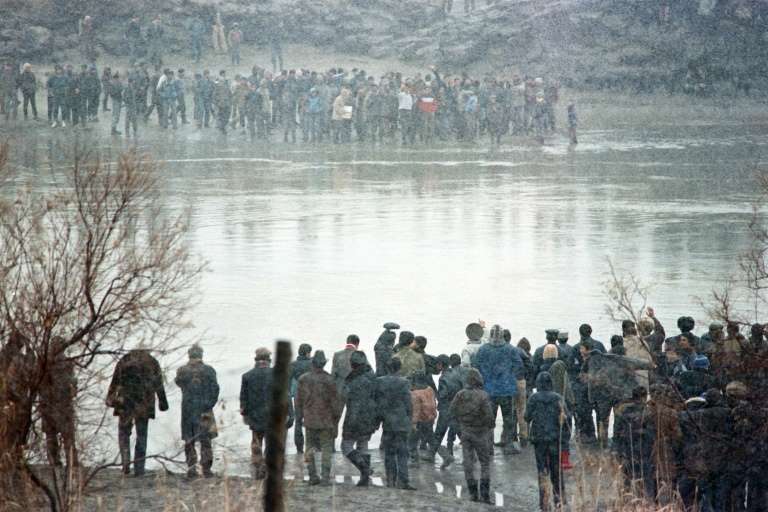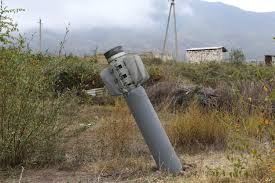October 30, 2020

Azerbaijani troops have made a major advance against Armenian ethnic forces in the area just north of the Iranian border during five weeks of fighting.
The main focus of the Azerbaijani war effort is the region that lies between Nagorno-Karabakh and Iran. It is for that reason that dozens of mortars and rockets have landed across the border in Iran, though only two people have been reported injured and none killed in Iran.
The main feature of this war has been the use by Azerbaijan of Israeli- and Russia-made drones to strike the tanks and vehicles of the ethnic Armenian forces. An analysis by a pair of men who have perused thousands of war photos is that Azerbaijan has disabled at least 144 Armenian tanks, a huge number in a small war.

Nagorno-Karabakh was not prepared for an attack from the air. It had placed many of its tanks in revetments to defend against attacks coming from the ground.
The small drones, however, have only small warheads with less than half the explosive power of American anti-tank weapons, so it isn’t clear how many of the tanks are destroyed and how many are repairable.
There has been fighting at many points along the “line of contact” that has separated Azerbaijani and Armenian ethnic forces since a ceasefire froze the fighting front in 1994. But Azerbaijan may only be attacking at those multiple points to pin down Armenian units and prevent them from sending re-enforcements to the south, where Azerbaijan appears to have focused its offensive.
Many analysts conclude that Azerbaijan is aiming to seize the Lachin corridor, the short highway link between Nagorno-Karabakh and the Republic of Armenia which is the lifeline for the Republic of Artsakh, as Nagorno-Karabakh styles itself. With that link severed, Artsakh would have difficulty getting all the supplies it needs for survival.
According to some reports, Azerbaijan was only 10 kilometers (six miles) from the Lachin Corridor as of October 22, though the truth of that claim could not be determined. As of November 1, there was still no Azerbaijani claim to have severed the Lachin link.
Nagorno-Karabakh is an enclave populated by about 150,000 ethnic Armenians that lies inside Azerbaijan. It is part of Azerbaijan because Josef Stalin put it there in the 1920s, although he carved out dozens of other much smaller ethnic enclaves in the Soviet Union and assigned them to be run by their nearby ethnic republic. The most prominent such enclave is Nakhichevan, an Azerbaijani-populated area that is separated from Azerbaijan by Armenia but run by Azerbaijan. (See map at right.)
Nagorno-Karabakh’s separation from Armenia didn’t make much difference when the Soviet Union lorded it over everything. But as the Soviet Union started to come apart in the late 1980s, the people of Nagorno-Karabakh rose up and rebelled against their Azerbaijani overlords. They not only drove their Azerbaijani governors out of Nagorno-Karabakh itself by 1994, but also conquered all the land between Nagorno-Karabakh on the one hand and Armenia and Iran on the other. Most of the people living in those conquered areas were Azerbaijani ethnics, many of whom fled their homes have lived as refugees ever since then.
In the quarter-century since then, Azerbaijan has prospered from oil and has built up a professional Army, armed partly by Russia and Turkey, but mainly by Israel, which has given considerable attention to Azerbaijan as the sole Muslim-majority country that is close to it. Azerbaijan has many frictions with Russia, which is clearly closer—politically, militarily and culturally—with Christian Armenia. The Azerbaijani-Israeli alliance has flourished—much to the annoyance of Iran.
Although Azerbaijan is one of only four Shiite majority countries in the world (Iran, Iraq, Bahrain and Azerbaijan), the Islamic Republic has long had a tense relationship with Azerbaijan. The main reason is that many citizens of Azerbaijan want to have Iranian Azerbaijanis united with their republic. The Baku government does not support that movement—but the previous Azerbaijani government did and the Islamic Republic figures the current government could change its policy or a future government could do so.
Furthermore, Armenia quietly helps Iran evade US sanctions while Azerbaijan strictly enforces them.
On top of that, Baku has often exploded in anger over efforts by the Islamic Republic to promote its official view of militant Shiism in Azerbaijan, such as by funding militant preachers in Azerbaijan. The Azerbaijani political establishment is the old Soviet establishment and is secular if not atheist.
When the Azerbaijanis of Iran launched pro-Azerbaijan street protests after Azerbaijan attacked Artsakh forces September 27 (see last issue of Iran Times, page three), Iran changed its long-term neutrality policy to express support for Azerbaijan. But it is unlikely that anyone in the Islamic Republic establishment—even Supreme Leader Ali Khamenehi, who is part Azerbaijani—actually wants Azerbaijan to win this war. As long as Azerbaijan is focused on Nagorno-Karabakh, Azerbaijan cannot focus on its brethren in Iran. If Azerbaijan swallows Nagorno-Karabakh, Baku could then shift its focus to its separated brethren and cause serious problems in Iran.
In addition, Turkey has staunchly backed Azerbaijan and has brought in Syrian militiamen (who have fought against the government of Syrian President Bashar al-Assad and Iran) to support Baku. Iran does not want Turkey to get a foothold north of its border with troops that hate Iran.
In the ground fighting, Azer-baijan has clearly prevailed—but at what is widely suspected to be great human cost. It has sent its troops attacking in First World War-style frontal assaults.
Artsakh troops have operated on a system of defense-in-depth. They have lines of defenses on the mountain ridges and drop back to the next line each time they are pressed. But they also leave mounds of Azerbaijani dead each time before withdrawing, according to news reports.
Azerbaijan has, however, used its Israeli and Russian drones, equipped with television cameras (popularly called kill-cams) to seek out targets, to strike Artsakh vehicles, supply dumps and troop concentrations. This appears to be the main Artsakh vulnerability and the main Azerbaijani initiative. The small drones are cheap and “pilots” can be easily trained. This demonstrates how the modern “precision strike” revolution in military tactics can be adopted by small countries and not just the big powers.
The Artsakh troops are struggling to defeat this aerial attack. Film from the front lines show Artsakh troops lying on their backs firing automatic rifles at the sky to try to knock out the drones before the drones can knock out the troops.
Both sides have been firing less accurate missiles into the other side’s cities. These are simply terror weapons, meant to blow up somewhere in a city and terrorize the civilians.
Armenia supports Artsakh. But it does not legally recognize Artsakh as an independent country—no country does. The Republic of Armenia is not known to have sent any military units into Artsakh, but it does send supplies and there are almost certainly young Armenian nationals who have volunteered and come to Artsakh. (There are also likely to be Azeri-speaking Iranians volunteering in Azerbaijan, but no one wants to talk about that.)
Still, the fact that Artsakh has survived as long as it has can be viewed as a surprise. It is a community of 150,000 people fighting Azerbaijan with 10 million people and oil wealth—and now with Israeli armaments.
Furthermore, Turkey is helping Azerbaijan—though the extent of the Turkish involvement is unclear, albeit vocal. Some think Turkish troops are operating drones. There are hundreds of Turkish military advisers in Azerbaijan and Turkish F-16 fighter jets have been photographed at an Azerbaijani airfield, though they have not been seen in the sky by Artsakh troops.
Moscow has negotiated two ceasefires, neither of which lasted more than a few seconds. The United States got involved late in October. But the ceasefire it proclaimed got nowhere, just like the Russian ones.
The Islamic Republic is very unhappy to have a war within hearing distance of its border communities. It has repeatedly complained of ordnance from the war falling on those border communities and threatened to take action to stop it. But the Islamic Republic has done nothing but repeat the warnings each time munitions have fallen inside Iran. It has sent a Pasdar “mechanized brigade” to the border as a show of toughness—but ground troops can’t stop mortars and rockets.
Azerbaijan is advancing and so has no need for a ceasefire. Artsakh troops are being pushed back and so its leadership might be desirous of a ceasefire—especially since it does not appear that Artsakh has lost many areas inhabited by ethnic Armenians. Furthermore, a ceasefire could give Artsakh the opportunity to readjust its military to better cope with the new tactics that Azerbaijan has used so successfully.
A ceasefire now would mean that Iran would no longer have any border with Artsakh—and that Azerbaijan will have taken a big chunk of the territory occupied by Artsakh. Azer-baijani President Ilham Aliyev announced that his troops controlled all the border with Iran on October 22.
As for casualties, Artsakh has announced military deaths just short of 1,000 on October 24. Azerbaijan has never announced any troop losses. Each side acknowledges fewer than 100 civilian deaths.
Several dozen munitions have landed on the Iranian side of the border, injuring a six-year old girl and a teenaged boy. Some homes have been damaged and several fields have been set afire.
Going beyond the rhetoric of the Islamic Republic, which now openly favors Azerbaijan to appease the Azeri speakers in Iran, the Islamic Republic certainly sees an Azerbaijani victory as a loss for Iran and a win for Israel and Turkey, while also freeing Azeri nationalists to be more vocal about joining the Republic of Azerbaijan with the Azeri speaking areas of Iran.
Iran says it has launched a peace initiative with Deputy Foreign Minister Abbas Araqchi visiting the concerned capitals. The Tehran media is filled with stories of all the great things Araqchi is doing, but no one else seems to be paying any attention.
France, Russia and the United States have together been trying to arrange a peace and on October 31 announced that the combatants had agreed to stop targeting cities with their missiles, to allow an exchange of the dead, and to inform the International Red Cross of the names of those taken captive. But that is far short of a ceasefire.
Russian President Vladimir Putin said a real peace should involve a return to Azerbaijan of the areas outside Nagorno-Karabakh that have been seized by Artsakh, a “special regime” for Nagorno-Karabakh and a secure link between Armenia and Nagorno-Karabakh.
Meanwhile, Micky Ahar-onson, former staffer with the Israeli National Security Council, said, “The Iranians have more to lose than gain” from an Azerbaijani victory. She said Iran “would be much happier to see the Armenians on the border than the Azerbaijanis, despite the fact that the Armenians are Christians and the Azerbaijanis are Shiites.”
She said, “Everyone except Turkey is in favor of ending the conflict. Turkey is the only one pushing Azerbaijan to pursue its ‘national interests’.”



















